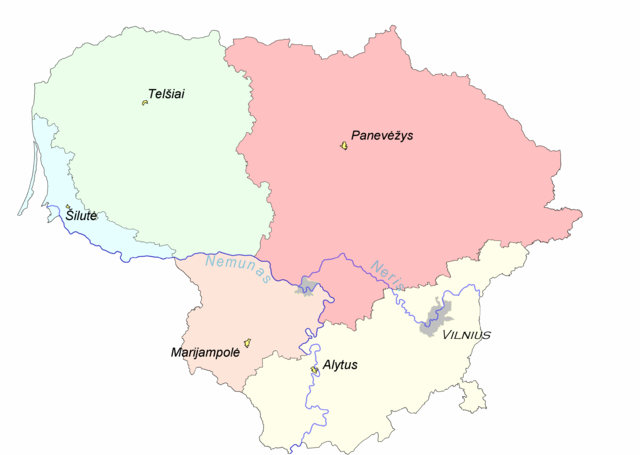Top Qs
Timeline
Chat
Perspective
Cultural regions of Lithuania
From Wikipedia, the free encyclopedia
Remove ads
Lithuania can be divided into five historical and cultural regions (called ethnographic regions). The exact borders are not fully clear, as the regions are not official political or administrative units. They are delimited by culture, such as country traditions, traditional lifestyle, songs, tales, etc. To some extent, regions correspond to the zones of Lithuanian language dialects. This correspondence, however, is by no means strict. For example, although the Dzūkian dialect is called South Aukštaitian, it does not mean that Dzūkija is part of Aukštaitija. In certain parts of some regions, dialects of other regions are spoken, while for example in Samogitia, there are three indigenous dialects (southern, northern and western Samogitian), some of which are subdivided into subdialects.[citation needed]



Remove ads
Regions in politics
Summarize
Perspective
No region, except for Samogitia, has ever been a political or an administrative entity. Throughout most of Lithuanian history the cultural regions of Aukštaitija, Suvalkija and Dzūkija were together known as the historical land of Lithuania Proper which was the core of the Lithuanian state during the Grand Duchy era. However, some work was done recently to delineate their boundaries more clearly, as there is a project to change the system of counties in Lithuania into ethnographic regions, which would be called lands (žemės). This project is also supported by the view that with the limited functions of counties, 10 of them are not needed for Lithuania. Another supporting argument is that in other countries historical territories are being revived, while in Lithuania artificially made counties exist. The project was supported by the former president Rolandas Paksas, yet now it is not clear when or if the project will be completed at all. However, Dzūkija quite recently adopted the coat of arms and emblem which would be used if the reform were to be implemented. Alytus County, which lies almost entirely within Dzūkija, adopted soon afterwards a coat of arms that is based on the Dzūkija coat of arms. Samogitia has a flag and a coat of arms dating from the time of the Duchy of Samogitia;[citation needed] these symbols are considerably older[citation needed] than the flag of Lithuania. Lithuania Minor has a flag used since the 17th century,[citation needed] and an anthem originating from the 19th century. However, if the reform were to be implemented, most likely there would be just four lands, not five, because most of Lithuania minor is located within the modern borders of Russia (in the Kaliningrad Oblast) and many Lithuanians were expelled from there. The relatively small remaining part is also populated mostly by relative newcomers, as much of the local population died in the Second World War or was expelled. Therefore, Lithuania minor would probably be attached to Samogitia.
Even though the regions are not political/administrative entities, most regions have their "capitals" (cities which are commonly considered to be capitals). These cities are not necessarily the largest in the region.
Remove ads
List of regions
Remove ads
See also
References
Wikiwand - on
Seamless Wikipedia browsing. On steroids.
Remove ads










